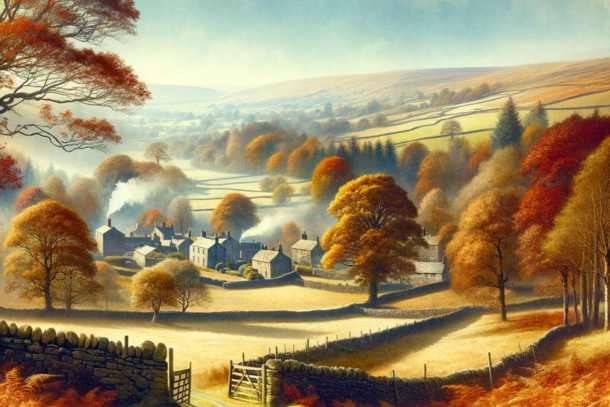Autumn's Lullaby: How Seasonal Shifts Shape Our Sleep Stages

The allure of autumn is undeniable. As the leaves transition to warm, earthy tones and the air begins to crisp, there's a palpable shift in our daily rhythms. Amidst these captivating changes, one facet of our lives remains paramount: sleep. The intricate dance of slumber, deeply intertwined with our health and well-being, often experiences its own transformation during this season.
The Pivotal Role of Sleep
Sleep isn't merely a time of rest; it is a complex physiological process that rejuvenates our body and mind. A lack of quality sleep can impinge upon our cognitive functions, mood regulation, and even immune responses. Furthermore, a consistent sleep routine fortifies our mental health, bolstering our resilience against stress and anxiety.
Autumn's Embrace and Sleep Patterns
But how does the season of golden leaves and cosy evenings influence this crucial aspect of our lives? The transition from the long, balmy days of summer to the shorter, cooler days of autumn might seem inconsequential. Yet, these subtle shifts in daylight exposure and temperature can deeply resonate with our internal body clocks, potentially altering our sleep patterns.
As we embark on this exploration of sleep in the context of autumn, we'll delve deeper into the science behind these changes. It’s a journey of understanding, empowering us to harness the best of the season for optimal rest and rejuvenation.
The Basics of Sleep Cycles
Sleep is a fascinating and complex process, integral to our health and well-being. Our bodies are not merely 'switching off' when we drift into slumber; rather, they embark on a structured journey through various stages of sleep. Each of these stages has a unique role in ensuring we wake up feeling refreshed and revitalised.
The Stages Unveiled
Sleep can broadly be classified into two main categories: Rapid Eye Movement (REM) sleep and non-REM sleep, the latter of which is further divided into three distinct stages.
-
NREM Stage 1: Often referred to as the 'transition phase', this is the period when you're just on the cusp of sleep. Lasting for a brief spell, typically a few minutes, your heartbeat, breathing, and eye movements begin to slow down, and your muscles start to relax.
-
NREM Stage 2: As you delve deeper into sleep, you enter this intermediate stage. Your body temperature drops, eye movement ceases, and your brain waves become slower, interspersed with brief bursts of activity known as sleep spindles.
-
NREM Stage 3: This is the deep sleep phase. It's during this period that the body performs many of its restorative functions, such as repairing tissues and bolstering the immune system. Waking up from this stage might leave you feeling groggy and disoriented.
REM Sleep: Occurring roughly 90 minutes after you initially fall asleep, this phase is characterised by rapid eye movement, increased brain activity, and vivid dreams. REM sleep plays a crucial role in memory consolidation and mood regulation.
The Symphony of Sleep
Understanding these stages underscores the symphonic nature of sleep. It's not about depth alone, but the sequence and progression through these stages that ensure holistic rest and recovery. By appreciating this intricacy, we can better tailor our sleep environments and habits to support this nightly dance of rejuvenation.
Autumn’s Effect on Our Biological Clock
Autumn, with its spectacular display of crimson leaves and crisp mornings, brings with it notable changes in our natural environment. One of the most subtle, yet profound shifts is its influence on our body's internal clock or circadian rhythm.
Understanding the Circadian Rhythm
At its core, the circadian rhythm is our body's innate 24-hour cycle that regulates a host of physiological processes, including sleep, hormone production, and body temperature. Primarily driven by the brain’s suprachiasmatic nucleus, it responds acutely to external cues, most notably, light and temperature.
Our eyes play a crucial role in this. As daylight wanes or changes in intensity, photoreceptors in our eyes communicate these alterations to our brain. In response, our brain adjusts the production of certain hormones, most notably melatonin, which governs our sleep and wakefulness.
The Autumnal Shift
As we transition from the lengthy days of summer to the shorter, often overcast days of autumn, our exposure to natural light diminishes. This can lead to our brains producing melatonin earlier in the evening, nudging us towards sleepiness sooner than we might experience in the brighter months.
Simultaneously, the drop in temperature that accompanies autumn evenings can further influence our sleep propensity. As our core body temperature decreases, it often signals to our system that it's time to wind down and prepare for rest.
In essence, autumn’s blend of diminishing light and cooler nights can naturally recalibrate our sleep-wake cycle, encouraging earlier bedtimes and potentially longer, more restorative nights of sleep. This seasonal shift, while sometimes challenging, can also be harnessed as a tool for better sleep hygiene and overall well-being.
Diving Deeper: Sleep Stages in Autumn
As the amber leaves of autumn cascade from the trees, our bodies and minds also undergo subtle transformations, particularly in the realm of sleep. Let’s delve into how the distinctive characteristics of autumn interact with each sleep stage.
NREM Stage 1 (Light Sleep)
The initial phase of our nightly rest, this stage is a brief transition from wakefulness to sleep, often lasting a mere few minutes. One's muscles start to relax, heart rate begins to slow, and consciousness starts drifting away. Yet, the earlier sunsets of autumn, coupled with the onset of cooler evenings, may lead us into this light sleep phase a bit quicker than during summer nights.
NREM Stage 2 (Intermediate Sleep)
Moving into a deeper state of rest, this phase accounts for approximately 50% of our sleep duration. Our body temperature drops, and brain waves show sudden bursts of rhythmic activity. Intriguingly, the ambient chill of autumn evenings can, for many, extend the time spent in this intermediate sleep stage, further consolidating restful slumber.
NREM Stage 3 (Deep Sleep)
The crescendo of restorative sleep, this stage is when tissue growth, cellular repair, and energy restoration occur. The body's need for this rejuvenative sleep could be heightened during autumn due to the body conserving energy for the colder months ahead.
REM Sleep (Dreaming)
Characterised by rapid eye movement, accelerated respiration, and vivid dreams, this phase is vital for memory consolidation and mood regulation. Factors such as autumnal dietary changes, with an inclination towards richer, warmer foods, combined with cooler room temperatures may enhance the vividness and duration of our dreaming phase.
Indeed, autumn casts a unique spell on our nightly journey through these sleep stages, emphasising the symbiotic relationship between nature's rhythms and our own.
The Autumnal Advantage: Benefits of Altered Sleep Patterns
Autumn, with its captivating hues and crisp air, brings about subtle yet impactful changes to our sleep patterns. As the environment transforms, our body too adjusts, often reaping unforeseen advantages from these changes.
Deep Sleep and Rejuvenation
One of the standout benefits observed during autumn is the potential increase in the duration of deep sleep. This third stage of NREM sleep is when our body works hard at cellular repair, immune function enhancement, and energy restoration. The cooler temperatures, coupled with early evenings, might create conditions conducive for longer, uninterrupted deep sleep, allowing us to wake up feeling more refreshed and rejuvenated.
The World of Vivid Dreams
Alongside the potential for enhanced deep sleep comes the possibility of experiencing more vivid dreams. The REM stage, where most of our dreaming occurs, can be influenced by various factors, including seasonal changes. Some suggest that the atmospheric ambience of autumn, with its sense of introspection and reflection, might stimulate more profound and memorable dreaming.
Melatonin and Its Increased Production
Melatonin, often dubbed the 'sleep hormone', plays a pivotal role in regulating our sleep-wake cycles. As the nights draw in and we experience more prolonged periods of darkness, our bodies might produce melatonin earlier in the evening. This natural adjustment aligns well with the season, preparing us for rest earlier and potentially leading to better sleep quality.
In essence, while we often celebrate autumn for its aesthetic beauty and festive occasions, its influence on our sleep patterns offers another reason to cherish this time of year. Embracing and understanding these shifts can pave the way for healthier, more restorative slumbers.
Challenges and Solutions
The transition from summer to autumn, while picturesque in its beauty, can introduce a host of challenges to our sleep. As the nights draw in and temperatures drop, our sleep patterns, naturally attuned to light and environmental cues, can undergo subtle disruptions.
Sleep Disruptions in the Autumnal Transition
The key disruptions often include difficulty in falling asleep, fragmented sleep, or even bouts of insomnia. The reasons are multifaceted:
- Shifts in Light Exposure: The earlier sunsets mean longer nights, which can confuse our circadian rhythms.
- Temperature Fluctuations: As we oscillate between the residual warmth of summer and the approaching cold, our body has to constantly adjust, which can affect sleep onset and quality.
- Dietary Changes: Autumn brings with it a change in available fresh produce and often a shift to richer, heavier meals, which can influence our sleep cycles.
Mitigating Sleep Disruptions: Practical Tips
Thankfully, with a bit of foresight and minor adjustments, these challenges can be effectively managed:
- Maintain Optimal Room Temperatures: Invest in good quality bedding suited for the cooler months and consider using thermostats or heaters with timers to ensure a consistent sleeping environment.
- Blackout Curtains: To counteract the earlier sunset and potential streetlights or car headlights, use blackout curtains. They ensure that the bedroom remains dark, offering a conducive environment for sleep.
- Dietary Considerations: While enjoying autumnal treats, be mindful of caffeine intake in the evenings and try to incorporate foods that promote sleep, such as almonds, turkey, and chamomile tea.
Understanding these challenges and actively seeking solutions ensures that even as the leaves change and the nights grow long, our sleep remains undisturbed and rejuvenating.
Conclusion
Autumn, with its picturesque landscapes and crisp, cool air, brings more than just a shift in the colours of the leaves; it also ushers in subtle yet impactful changes to our nightly sleep cycles. As we've journeyed through this exploration, we've seen how the interplay between the season's shorter days, cooler temperatures, and our body's biological processes can influence the various stages of sleep.
The Seasonal Dance of Sleep Stages
Every night, as we close our eyes and drift into slumber, our bodies embark on a rhythmic dance through the stages of sleep. Autumn, in its unique way, choreographs this dance slightly differently. Whether it's a longer sojourn into the depths of deep sleep or a more vivid escapade into the realms of REM sleep, the season leaves its mark on our nocturnal journeys.
Adapting for a Restorative Rest
Awareness is the first step towards embracing and benefitting from these seasonal shifts. By recognising how autumn's embrace affects our sleep, we can make informed decisions — be it adjusting our bedtime routines, moderating our evening meals, or setting the ideal room temperature. Each small adaptation not only aids in achieving a night of undisturbed sleep but also ensures that we wake up feeling refreshed, rejuvenated, and ready to face the day.
In essence, as the world outside transforms with the hues of autumn, understanding these changes allows us to align our internal rhythms, granting us the gift of optimal rest during this reflective season.
Related to this article are the following:
- Embracing Autumn: Sleep Routines for the British Season
- Unwind and Recharge: The Benefits of Howling Wind and Rain Sounds for Sleep
- Unlock the Power of Naps: 10 Surprising Facts about Daytime Napping
- The Benefits of Daytime Napping: How a Short Power Nap Can Improve Your Productivity, Mood, and Health
- 10 Autumn Activities to Help You De-Stress
I do hope you have enjoyed this article and hope that you will subscribe to my newsletter so you can get the latest information about all things naturally relaxing.
Stay in touch, join the Naturally Relaxing Newsletter
Newsletter Signup
Post Your Comments
or post as a guest
Be the first to comment.
Latest articles in Sleep

The Power of Waterfall Sounds for Enhanced Sleep Quality

Embracing Autumn: Sleep Routines for the British Season

Autumnal Slumber: Understanding Our Seasonal Sleep Patterns

Crafting the Ideal Autumnal Sleep Sanctuary

Savouring Autumn: Foods to Enhance Your Sleep






